ART NOUVEAU RESTAURANTS OF THE BELLE EPOQUE IN PARIS
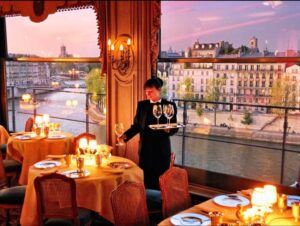
One of the great attractions with Paris is that it is, as everyone knows, a great food destination. Whether it’s the many outdoor produce markets (some sources say 69, others say over 80!), or the wide variety of bistros, brasseries, restaurants and famous landmarks such as La Tour d’Argent that boast impressive Michelin stars, the city has more dining options than can ever be explored in a lifetime. As well as great food, a number of Parisian restaurants are historic gems with fabulous interiors that are an attraction in themselves.
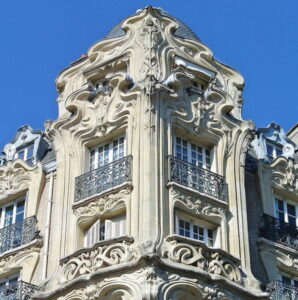
Paris has a rich legacy of restaurants from the Belle Epoque years—roughly 1890-1914—that have still retained their Art Nouveau décor. This was a lively and artistic period in the city, kicked off by the inauguration of the Eiffel Tower in 1889, and abruptly ended by World War 1. The Art Nouveau style had spread throughout Europe during these years, and the various World Fairs in Paris in 1878, 1889 and 1900 promoted its influence and accelerated the spread of the style. Naturally, restaurants were quick to follow the trend.
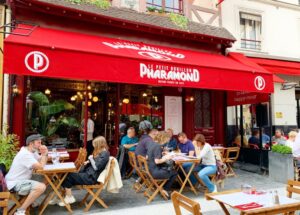
The ancestor of the modern Parisian brasserie is a category of eatery that became known as Bouillons. These were cheap ‘n cheerful, often spacious eateries, that usually served simple, traditional French cuisine, in particular a “bouillon” which has provided the name for this class of restaurant.
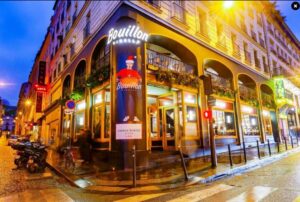
The concept was to serve good quality food quickly, at an affordable price, that included a single dish of meat and a bouillon (soup or broth) to the workers of the market halls. The first bouillon in Paris opened in 1767 on rue des Poulies in the 1st arr., specialising in consommés or ‘restaurants’ (which, interestingly, and somewhat confusingly, at the time referred to bouillon broth), opened by a man named Boulanger. It closed around 1854 when the street was torn down. That same year, another Bouillon was opened by a butcher, Adolphe-Baptiste Duval. By 1900, nearly 250 bouillons could be found in Paris. In effect, they became the first popular chain of restaurants.
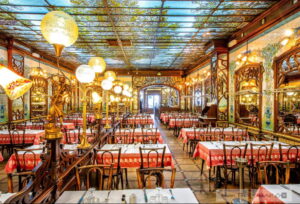
During the early years of the 20th century, bouillons were widely frequented and became an integral part of the Parisian culinary culture. However, their popularity declined over the years as the dining scene evolved, and many bouillons closed down. Fortunately, there are a few authentic bouillons remaining, such as Bouillon Chartier, Bouillon Pigalle, Bouillon Julien and Bouillon Racine, and they take great pride in being able to maintain their wallet-friendly prices. Most of these have also retained their Art Nouveau décor, so a visit is a real treat for the senses.
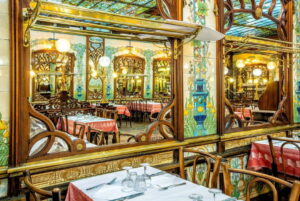
In 1896, Bouillon Chartier was opened by brothers Frédéric and Camille Chartier at no. 7 rue du Faubourg Montmartre. It has a beautiful, original Art Nouveau interior—a large, mirrored dining room with high, decorative stained glass ceilings and a mezzanine which makes the space seem even bigger. Brass railings, carved timber panelling, white glass globe lighting, and painted ceramic tiled walls typical of the Art Nouveau style. Paper overlays on the tables are used by the waiters to scrawl your order, and as there’s always a crush of diners, there’s a fair chance you’ll be sharing a table with others. Dinner isn’t a relaxed affair here, and it’s definitely not a place for a quiet, intimate dinner, as the waiters in bowties rush about, barely taking a breath. The food is super-cheap, and certainly not “gourmet” in any way. Bouillon Chartier is a Paris institution, and the main attraction, frankly, is the stunning, original Art Nouveau décor.
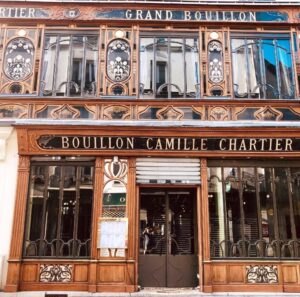
The Chartier Brothers created two other Bouillons in 1906. One is Bouillon Racine, located at no. 3 rue Racine in St Germain des Pres, in the 6th arr., which is between the Latin Quarter, Odeon and Saint Michel. The beautiful décor is in the typical Art Nouveau style: carved wood and ceramics, with mirrors and glass paintings. Camille Chartier kept the restaurant until 1926. After several owners, in 1962, the University of Paris opened a restaurant there for the staff and it remained operational until 1993.
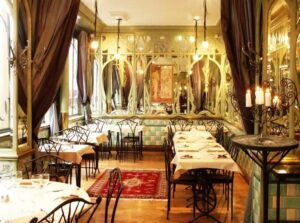
By then, it was looking shabby and badly in need of repairs and some restoration work. A complete renovation took place in 1996, thanks to the “Companions of the Duty”, who called in craftspeople who still had expertise in almost lost techniques and skills. Bevelled mirrors, painted ceramics, stained glass, carved woodwork, marble mosaics and gold-leaf lettering were restored to their original condition.
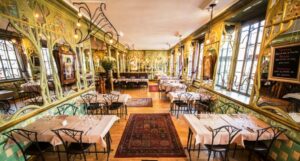
Bouillon Racine has since been classified as an Historic Monument. The restaurant has two floors, and is open daily. The food is excellent and the menu changes seasonally. The head chef was awarded a Michelin star at one of his previous restaurants, so a visit will be gastronomically very worthwhile!
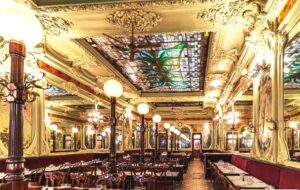
Bouillon Julien at no. 16, rue du Faubourg Saint-Denis in the 10th arr., remains one of the best preserved examples of the Art Nouveau style, certainly in Paris. Over the years, it has been the favoured haunt of many well-known figures such as Edith Piaf and her lover Marcel Cerdan, the champion boxer, who would regularly dine here at table no. 24. The building was constructed in 1906, and decorated by a number of exceptional artisans working in the Art Nouveau style. Armand Segaud created the peacock panels, while the mahogany bar is attributed to famed ‘École de Nancy’ woodworker, Louis Majorelle, who also designed the furniture.
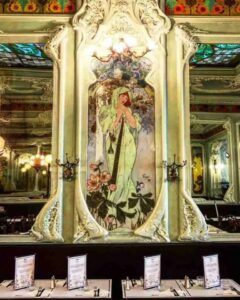
The master glassmaker Louis Trezel, inspired by the iconic images of Alfons Mucha, created 4 magnificent “flower women.” Famous ceramist Hippolyte Boulenger designed the patterns of the tiles—a veritable carpet of flowers, with its combination of geraniums and daisies. The beautiful stained glass ceiling is a fine example of the Art Nouveau style. The restaurant underwent a careful restoration in 2018, which reinstated the original wall colour of Céladon green, an emblematic colour of the era. Bouillon Julien is open every day until midnight. The inexpensive, classic bouillon food is good, although truth be told, the beautiful interior may be the bigger attraction.
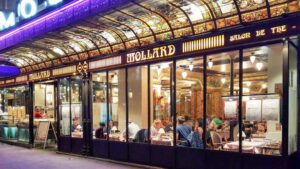
Aside from the Bouillons—and those mentioned above are by no means the only ones—there are numerous other spectacular Art Nouveau interiors of other bistros, cafes and restaurants in Paris. From its humble beginnings in 1867, Mollard benefitted greatly from its location at no. 115 rue Saint-Lazare, directly across from the newly built Gare St Lazare, . By 1895, Monsieur Mollard’s success was such that a new and grander remodel was warranted to match the status of his popular brasserie.
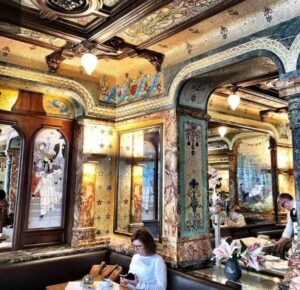
The task was assigned to famed Belle Epoque architect, Édouard-Jean Niermans, designer of the Negresco Hotel in Nice, the Hotel de Paris in Monte Carlo, Angelina’s Tea Room at no. 226 rue de Rivoli, and the Moulin Rouge. Niermans designed the mosaics, chairs, tables, light fixtures and even the coat racks. When the project was complete, Mollard was hailed by local newspapers as the most chic and modern restaurant in Paris. During the Nazi occupation of Paris during WW2, Mollard provided a free daily soup line to the hardest hit members of its neighbourhood throughout the occupation. Like many of its fellow Art Nouveau dining rooms, Mollard’s fantastic decor was covered over in paint and large mirrors some time in the first half of the 20th century and not rediscovered until 1965. In 1989, it was added to the register of Monuments Historiques.
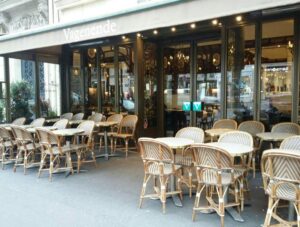
If you didn’t know about the Art Nouveau gem Brasserie Vagenende, you’d probably walk past it, with its pleasant but unassuming façade. But if you stopped and headed straight inside, you would find yourself back in 1904, when the Chartier brothers bought a pretty patisserie to transform it into a beautiful brasserie. The Vagenende family took over in the 1920s, protecting this treasure in a fast-changing world.
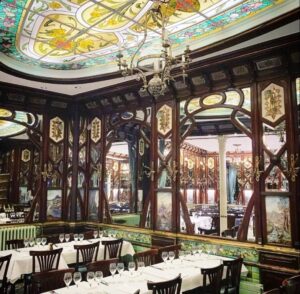
When a supermarket threatened to take over the space in the 1960s, French Culture Minister Andre Malraux stepped in as saviour—as he did for so many historic Parisian places as well as famous towns such as Sarlat in the Dordogne. He had Brasserie Vagenende listed as a Monument Historique, and its sumptuous interior is now exquisitely preserved. The food is hearty, traditional, homemade French dishes such as platters of charcouterie, onion soup, chateaubriand steaks, fresh fish, and traditional desserts along the lines of crème caramel and profiteroles. It’s located at 142 Bvd St Germain, in the 6th arr.
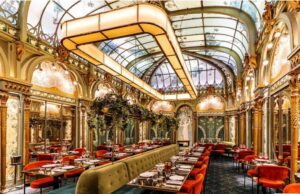
Regarded by many as the city’s most spectacular Art Nouveau interior, Beefbar, is located at 5 rue Marbeuf in the 8th arr. This veritable masterpiece of Art Nouveau was listed as a Monument Historique in 1983. The main hall, under a majestic glass roof, is adorned with murals, stained glass and glazed ceramics, creating a luxurious yet intimate atmosphere. The real story of Beefbar though is that the room was, from 1898, the winter-garden-style restaurant of the old Langham Hotel. Once the hotel closed down, its building was repurposed for other needs and businesses. As WW2 approached, the Art Nouveau jewel of a restaurant was boarded up for protection from the Nazis. It was then completely forgotten about, until new owners of the corner cafeteria found the hidden room in the late 1970s during renovations for what would become La Fermette Marbeuf, a local institution of an eatery in the 1980s and ‘90s.
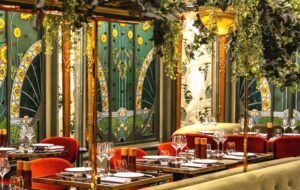
In 1982, a similar discovery was made at Maisons-Laffitte. A winter garden identical to the one mentioned, was auctioned off and saved from a tragic fate. The stained glass and tiles, meticulously dismantled and numbered, were integrated into La Fermette Marbeuf. It was renamed Beefbar in 2018. This is not exactly a cheap ‘n cheerful—no surprise, given its location, between rue Francois 1er and Ave. George V, not far from the Champs Elysees. When making a reservation, be sure to ask to be seated in an Art Nouveau room.
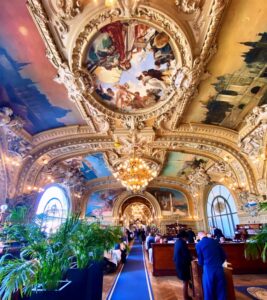
The largest, and one of the most impressive, Art Nouveau restaurants in Paris is Le Train Bleu at the Gare de Lyon. As Paris was about to host a major new Universal Exhibition in 1900, the Gare de Lyon, with trains to Lyon, Marseille and the Riviera, had to take the appearance of a palace. The project was entrusted to architect Marius Toudoire, who built the 64m high clock-tower, the monumental façade of the railway station, and a prestigious restaurant, symbol of travel, comfort and luxury. Le Train Bleu was inaugurated in 1901, so named because the sleeping cars on the trains were dark blue. Gilding, mouldings, chandeliers, frescoes representing the cities served by the railway line, and landscapes that travellers would see during their journey to Marseille, Monaco or Nice.
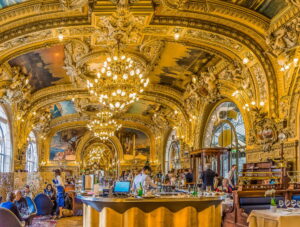
As well, there are portraits of actresses Sarah Bernhardt and Gabrielle Rejane, and the author of ‘Cyrano de Bergerac’, Edmond Rostand. Many films have been shot on location at Le Train Bleu, and over the years celebrities flocked there. Coco Chanel, Brigitte Bardot, Jean Cocteau, Colette and Marcel Pagnol were regulars. The menu consists of traditional, classic dishes such as La Coquille Saint-Jacques, La Bouillabaisse, house-smoked salmon, Gigot of lamb etc. Expensive. The restaurant has been a Monument Historique since 1972.
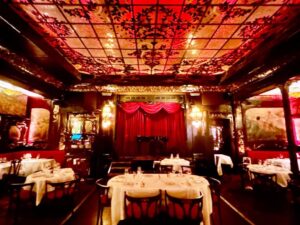
Last but not least on this list is undoubtedly the most famous restaurant in Paris, Maxim’s. The restaurant dates from 1893, and boasts an iconic, wonderful interior, which has been described as something akin to an Art Nouveau forest: candelabra that look like exotic trees and light shades like night blooming flowers, wall murals of cavorting nymphs, lush floral carpet, a botanically decorated stained-glass ceiling. It’s all very glamorous, designed to make everyone look all the more beautiful, and that’s likely one reason why the beau monde, from Marcel Proust to Brigite Bardot, made Maxim’s their second home for decades.
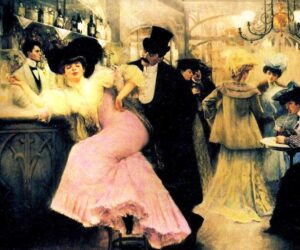
The moody lighting and garnet-and-gold detailing make for a dark, sensuous effect, which may explain why Maxim’s earned a reputation, “back in the day”, as the restaurant for mistresses, not wives. Many of us may recall a pivotal scene from the 1958 film ‘Gigi’ where Maxim’s was the perfect backdrop. These days, the restaurant is perhaps more the go-to for cashed-up tourists, and yes, it is expensive! It’s located at 3 rue Royale in the 8th, not far from Place de la Concorde.
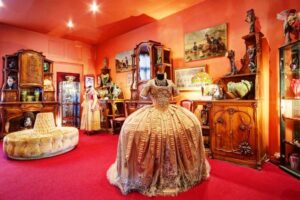
If dining at the restaurant is out of the question (understandable!), consider a visit to Musée Maxim’s, located above the restaurant. It reconstructs the apartment of a courtesan who experienced the “jet-set” lifestyle of the 1900s, with masterpieces by Tiffany, Majorelle and Massier.
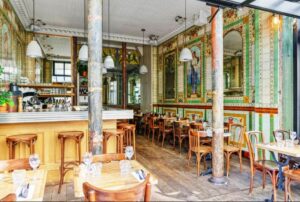
This is just a short run-down on Art Nouveau restaurants in Paris. Others to check out include Poulette, that dates back to 1906, well-known for its extraordinary Art Nouveau tiles, artfully winding flowers, curvy urns, and allegories to coffee and beer. It also has a classic zinc-topped bar. Its menu is totally modern, and serves biodynamic wines. Find it at 3 rue Etienne Marcel in the 1st arr. not far from Saint Eustache church.
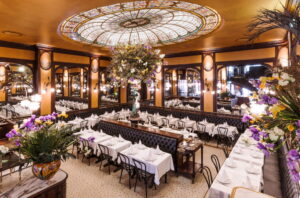
Another Monument Historique to look out for is Petit Bouillon Pharamond, also in the 1st arr. at 24 rue de la Grande Truanderie, near Les Halles. It has a fine Art Nouveau interior, and the food is inexpensive, specialising in the cuisine of Normandy. If you’re in the neighbourhood, check out Brasserie Bofinger at 5-7 rue de la Bastille in the 4th arr. Specialising in Alsatian specialties, it’s a Paris institution.
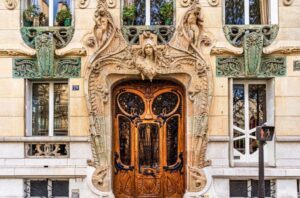


You’re making me hungry.
Hi Nadine,
Totally agree that beautiful surroundings can work up an apetite!
Cheers, Cheryl
Cheryl
Thank-you for a wonderful tour of art noveau. I have been lucky to eat in one of the bouillons named and yes, I have undoubtedly walked past the Brasserie Vagenende. Next time I will pay more attention.
Hi Anna,
So glad you enjoyed your trip down (culinary) memory lane! As I mentioned, with some of the Bouillons, it’s more a case of admiring the stunning interiors rather than the food, although some have very good food. You’re right about Brasserie Vagenende: it’s easy not to notice it, and like you, shall have yet another, closer look next time we’re in the neighbourhood. Regards, Cheryl